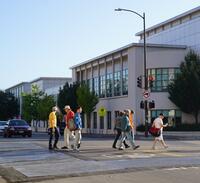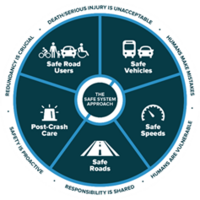SafeTREC research in progress
Explore our current research projects on the Safe System approach to road safety and Vision Zero.
Assessing How Private Beliefs Conflict with Public Action on Safe Systems
This project will reveal and reconcile the sizable gap between what members of the public most want from their transportation system and what they believe others—including policymakers—want from the system. Research on pluralistic ignorance with respect to transportation investment priorities can aid in bridging the chasm between Safe Systems theory and practice, and signal to policymakers and the public that equitable and safe access to services and community life is more widely valued than is commonly believed. Learn more.
Research Team: Seth LaJeunesse and Jill Cooper.
Developing a Safe System Approach to Setting Speed Limits
Research Team: Offer Grembek.
A Framework for the Protective Features of a Safe System
Transportation safety professionals strive to build a system on which no street user can be severally or fatality injured on. To accomplish such a safe system, it is necessary to effectively harness all the core protective opportunities provided by the system. Despite the increasing consensus that this needs to be thought of as a systems problem, the considerations for each of these layers of protection are siloed, and many of the protective features are evaluated in terms of potential lives saved due to a specific improvement. The proposed research will examine what happens when we no longer assume each of the individual components holds a desirable level of protection for a certain circumstance, but that they contribute to a larger joint entity (i.e., the system) that can exhibit the required characteristics or traits (i.e., safe). The conjecture here is that there is a set of protective features that can jointly fulfill the promise of a safe system. Learn more.
Research Team: Offer Grembek.
Integrating Systems Thinking Tools into Vision Zero and Safe System Approaches
In this project, we propose developing systems thinking-based content and guidance materials to strengthen the implementation of Vision Zero and Safe System approaches. This project will develop materials that help stakeholders establish a firm foundation and deepen their understanding of the system (of policies, norms, funding streams, equitable/inequitable processes, etc.) underlying their road safety outcomes, setting the stage for more effective VZ planning and implementation. Learn more.
Research Team: Becky Naumann, Jill Cooper, seth LaJeunesse, Nancy Pullen-seufert, Kelly Evenson, Elyse Keefe, and Kristen Hassmiller Lich.
Safe System Academy
The essence of this project is to develop the foundation of a Safe System Academy that would provide training services to various stakeholders across the state. Achieving the goals of the project would provide an opportunity for California to more intentionally pursue activities that are needed to implement a Safe System framework. Learn more.
Research Team: Offer Grembek.
Structures of Stakeholder Relationships in Making Road Safety Decisions

Traffic fatalities on U.S. roadways have risen in recent years. Meanwhile, the transportation system and the society it serves is growing increasingly complex. What is needed are systems, tools, and methods that can advance the state of road safety practice. Thus, with the aim of uncovering and accelerating productive cross-sector collaboration and effective safety countermeasure implementation, the R1 research team drew upon Diffusion of Innovations theory and strategies to “design for diffusion” to devise a three-phase exploratory study. Learn more.
Research Team: Seth LaJeunesse, Steve Marshall, and Jill F. Cooper.
Urban Freight and Road Safety: Trends and Innovative Strategies
in this study we conducted a systematic review to identify last-mile delivery strategies and to determine how those strategies have been evaluated in the literature. We found 21 unique last-mile delivery strategies, assigning them to 4 meaningful categories –innovative vehicles, urban goods consolidation, technological and routing advancements in city logistics, and emerging planning tools and policies. Our analysis found that researchers had analyzed the impact of urban logistics strategies around four impact areas: operational, environmental, social, and economic considerations. Learn more.
Research Team: Noreen McDonald, Becky Naumann, Christopher Cherry, and Offer Grembek.

